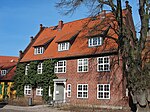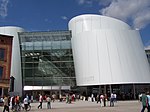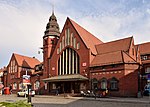Stralsund Theatre
Culture of Mecklenburg-Western PomeraniaGerman theatre stubsMecklenburg-Western Pomerania geography stubsStralsundTheatre in Germany ... and 1 more
Theatres completed in 1914

The Stralsund Theatre (German: Stralsunder Theater) in the German town of Stralsund has a long tradition. Performances of theatre pieces on the Alter Markt are documented in the years 1553 ("Tragedie van deme Daniel") and 1584 ("De Tragedien van Susannen"). The present building was designed by Carl Moritz and opened in 1914. The tradition has continued since the merger of the theatres of the towns of Stralsund and Greifswald in 1994 into the Theatre of West Pomerania (Theater Vorpommern).
Excerpt from the Wikipedia article Stralsund Theatre (License: CC BY-SA 3.0, Authors, Images).Stralsund Theatre
Olof-Palme-Platz,
Geographical coordinates (GPS) Address Phone number Website External links Nearby Places Show on map
Geographical coordinates (GPS)
| Latitude | Longitude |
|---|---|
| N 54.31741 ° | E 13.08844 ° |
Address
Großes Haus Stralsund
Olof-Palme-Platz 6
18439 , Altstadt
Mecklenburg-Vorpommern, Germany
Open on Google Maps










